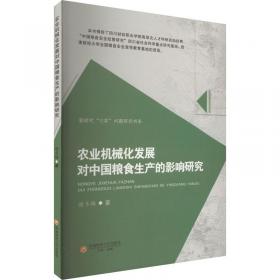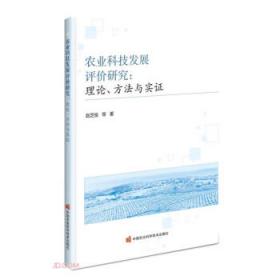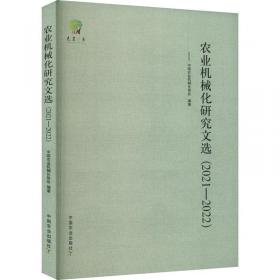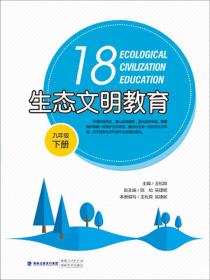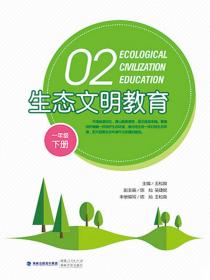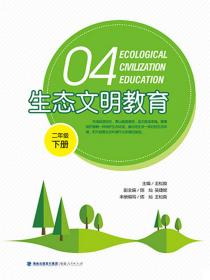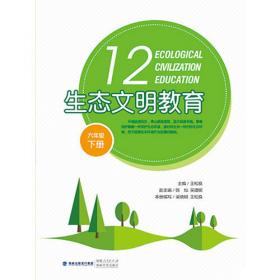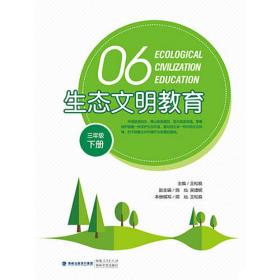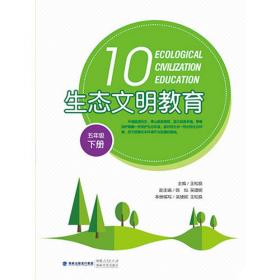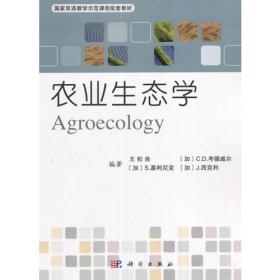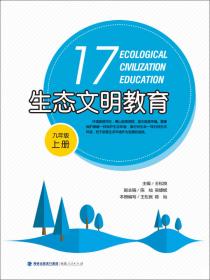农业生态学(Agroecology)(第二版)
出版时间:
2021-06
版次:
1
ISBN:
9787030684158
定价:
69.80
装帧:
平装
开本:
16开
纸张:
胶版纸
页数:
309页
1人买过
-
《农业生态学(第二版)》是“国家双语教学示范课程”配套教材,也是福建农林大学与加拿大戴尔豪斯大学(Dalhousie University)本科教育合作项目(2012年至今)的成果之一。
《农业生态学(第二版)》紧紧围绕“农业是把太阳光转变成人们健康、幸福生活的产业”这一在世界农业面临全面生态化转型背景下对“农业”的本质过程和根本目标的理解,把“农业生态学”定义为地球演化进入“人类世”的农业系统学科,它既是指导农业生态转型的一种科学,也是推进农业生态转型的一种实践,更是实现全球可持续的食品体系的一种社会运动。为此,《农业生态学(第二版)》主要介绍农业生态学的学科内涵、农业生态系统的基本过程及人为问题,以及可持续农业生产系统的构建与管理等内容。 Contents
Part Ⅰ Context of Agroecology
Chapter 1 Agriculture and Its Anthropocentric Sciences 3
1.1 Introduction and the Anthropocene Era 3
1.2 What Are the “Hot” Issues in Agriculture and Food System? 5
1.3 Agriculture, Agricultural Sustainability, and Agroecology 6
1.4 Corn as a Symbol of Agroecology 14
Chapter 2 Natural Ecosystems Versus Agroecosystems 17
2.1 Expanding Our Understanding of “Ecology” 17
2.2 Natural Versus Agricultural Ecosystems 19
2.3 Energy Flow and Matter Cycle in a Natural Ecosystem 22
2.4 Agroecosystems Harvest the Sun 24
2.5 Matter Cycle and Agroecosystems 25
2.6 Ecological Footprint 26
Part Ⅱ Basics of Agroecosystems
Chapter 3 Soils as the Basis for Cultivated Ecosystems 31
3.1 Introduction 32
3.2 Formation and Classification of Soils 32
3.3 Ecosystem Services Provided by Soils 33
3.4 Soil Characteristics 35
Chapter 4 Water as the Basis for Cultivated Ecosystems 47
4.1 Water Resources in the Global Ecosystem 47
4.2 Water in Agroecosystems 50
4.3 Aspects of Water Management in Agroecosystems 54
Chapter 5 Linking Agroecosystems to Food Systems 57
5.1 Food Systems in Association with Agroecosystem 57
5.2 Agroecological Transition: Making Money and Respecting the Environment 58
5.3 Concept of Sweet Spot 61
5.4 Educating Consumers with Agroecology 61
Chapter 6 Agroecosystem Health and Services 63
6.1 What Is Ecosystem Health and How Does It Relate to Ecosystem Services? 64
6.2 Evaluating Agroecosystem Health and Services 71
Part Ⅲ Digging Deeper into Agroecosystems
Chapter 7 Agroecology and Hunger 79
7.1 Hunger Concepts and Definitions 80
7.2 Causes for Hunger 83
7.3 Green Revolutions 88
Chapter 8 Wastes or Resources in Agroecosystems? 93
8.1 What Are Resources and Wastes in Agroecosystems? 94
8.2 Resources in Agroecosystems 95
8.3 Waste in Agroecosystems 96
8.4 Compost: Making It 98
8.5 Vermicomposting 105
8.6 Agricultural Uses of Compost 105
Chapter 9 Global Climate Change and Agriculture 107
9.1 What Is the Evidence for Climate Change? 107
9.2 What Is the Greenhouse Effect and How Is It Related to Climate Change? 110
9.3 Other Greenhouse Gases 114
9.4 Agriculture’s Contribution to the Greenhouse Gases and Global Climate Change 116
9.5 Impacts of Global Climate Change on Agriculture 117
Chapter 10 Agrobiodiversity and Agroecosystem Stability 123
10.1 Biodiversity and Its Associated Ecosystem Services 123
10.2 Biodiversity in Agroecosystems 128
10.3 Regenerating Biodiversity in Agroecosystems 131
Part Ⅳ Application of Agroecosystem Concepts
Chapter 11 Domestication in Agricultural Systems 141
11.1 Introduction 141
11.2 Adaptations for Wild Species Versus Adaptations for Domesticated Species 142
11.3 How Did Domestication Allow for an Increase in Human Population? 144
11.4 Domestication and Evolution of Agriculture 145
11.5 Is Animal Production Good for Humans and the Planet? 146
11.6 Is Domestication Exploitation? 147
Chapter 12 Animal Welfare: A Good Life for Animals 151
12.1 Introduction 151
12.2 Principal Animal Welfare Issues in Modern Animal Agriculture 152
12.3 Animal Welfare: Observations and Research 154
12.4 Scientific Research 156
12.5 International Approaches to Implementation of Animal Welfare and Their Impacts 160
Chapter 13 Forage-Based Production Systems 163
13.1 Introduction 163
13.2 Forages in Production Systems 164
13.3 Beneficial Effects of Forages 165
13.4 Harvesting and Storing Forage 167
13.5 Forages in Rotations 168
Chapter 14 Cereal-Based Cropping Systems 171
14.1 Introduction: Why Are Seeds of Cereals So Great? 171
14.2 Domestication and Adaptation of Cereals 174
14.3 The Major Cereal Crops in the World 175
14.4 Cropping Strategies with Cereals 178
14.5 Strategies for Improving Cereal Crops to Meet Future Needs 179
Chapter 15 Vegetable-Based Production Systems 181
15.1 The Roles of Vegetable in Human Development 181
15.2 Nutrient Deficiencies 182
15.3 Socioeconomic Impact 183
15.4 Classification Systems of Vegetables 185
15.5 Vegetable-Based Production Systems 187
15.6 Profit Versus Principle 189
Chapter 16 Perennial Fruit and Nut Production Systems 191
16.1 Perennial Woody Plants in Agroecosystems 191
16.2 Economics and Health with Fruit and Nut Crops 193
16.3 Growing Fruits and Nuts 194
16.4 Biotechnology and the Papaya: A Case Study in Hawaii 196
16.5 Almonds and Water: Case Study 197
16.6 Agroforestry and Its Techniques 198
Chapter 17 Aquaculture Production Systems 201
17.1 Aquaculture Must Grow in the Twenty-first Century 201
17.2 The Role of Aquaculture in Human Nutrition 203
17.3 Methods and Energy Efficiency in Finfish Aquaculture 204
17.4 Sustainability of Aquaculture: Global Perspective 208
Chapter 18 Environmental Innovations in Urban Ecosystems 211
18.1 U
-
内容简介:
《农业生态学(第二版)》是“国家双语教学示范课程”配套教材,也是福建农林大学与加拿大戴尔豪斯大学(Dalhousie University)本科教育合作项目(2012年至今)的成果之一。
《农业生态学(第二版)》紧紧围绕“农业是把太阳光转变成人们健康、幸福生活的产业”这一在世界农业面临全面生态化转型背景下对“农业”的本质过程和根本目标的理解,把“农业生态学”定义为地球演化进入“人类世”的农业系统学科,它既是指导农业生态转型的一种科学,也是推进农业生态转型的一种实践,更是实现全球可持续的食品体系的一种社会运动。为此,《农业生态学(第二版)》主要介绍农业生态学的学科内涵、农业生态系统的基本过程及人为问题,以及可持续农业生产系统的构建与管理等内容。
-
目录:
Contents
Part Ⅰ Context of Agroecology
Chapter 1 Agriculture and Its Anthropocentric Sciences 3
1.1 Introduction and the Anthropocene Era 3
1.2 What Are the “Hot” Issues in Agriculture and Food System? 5
1.3 Agriculture, Agricultural Sustainability, and Agroecology 6
1.4 Corn as a Symbol of Agroecology 14
Chapter 2 Natural Ecosystems Versus Agroecosystems 17
2.1 Expanding Our Understanding of “Ecology” 17
2.2 Natural Versus Agricultural Ecosystems 19
2.3 Energy Flow and Matter Cycle in a Natural Ecosystem 22
2.4 Agroecosystems Harvest the Sun 24
2.5 Matter Cycle and Agroecosystems 25
2.6 Ecological Footprint 26
Part Ⅱ Basics of Agroecosystems
Chapter 3 Soils as the Basis for Cultivated Ecosystems 31
3.1 Introduction 32
3.2 Formation and Classification of Soils 32
3.3 Ecosystem Services Provided by Soils 33
3.4 Soil Characteristics 35
Chapter 4 Water as the Basis for Cultivated Ecosystems 47
4.1 Water Resources in the Global Ecosystem 47
4.2 Water in Agroecosystems 50
4.3 Aspects of Water Management in Agroecosystems 54
Chapter 5 Linking Agroecosystems to Food Systems 57
5.1 Food Systems in Association with Agroecosystem 57
5.2 Agroecological Transition: Making Money and Respecting the Environment 58
5.3 Concept of Sweet Spot 61
5.4 Educating Consumers with Agroecology 61
Chapter 6 Agroecosystem Health and Services 63
6.1 What Is Ecosystem Health and How Does It Relate to Ecosystem Services? 64
6.2 Evaluating Agroecosystem Health and Services 71
Part Ⅲ Digging Deeper into Agroecosystems
Chapter 7 Agroecology and Hunger 79
7.1 Hunger Concepts and Definitions 80
7.2 Causes for Hunger 83
7.3 Green Revolutions 88
Chapter 8 Wastes or Resources in Agroecosystems? 93
8.1 What Are Resources and Wastes in Agroecosystems? 94
8.2 Resources in Agroecosystems 95
8.3 Waste in Agroecosystems 96
8.4 Compost: Making It 98
8.5 Vermicomposting 105
8.6 Agricultural Uses of Compost 105
Chapter 9 Global Climate Change and Agriculture 107
9.1 What Is the Evidence for Climate Change? 107
9.2 What Is the Greenhouse Effect and How Is It Related to Climate Change? 110
9.3 Other Greenhouse Gases 114
9.4 Agriculture’s Contribution to the Greenhouse Gases and Global Climate Change 116
9.5 Impacts of Global Climate Change on Agriculture 117
Chapter 10 Agrobiodiversity and Agroecosystem Stability 123
10.1 Biodiversity and Its Associated Ecosystem Services 123
10.2 Biodiversity in Agroecosystems 128
10.3 Regenerating Biodiversity in Agroecosystems 131
Part Ⅳ Application of Agroecosystem Concepts
Chapter 11 Domestication in Agricultural Systems 141
11.1 Introduction 141
11.2 Adaptations for Wild Species Versus Adaptations for Domesticated Species 142
11.3 How Did Domestication Allow for an Increase in Human Population? 144
11.4 Domestication and Evolution of Agriculture 145
11.5 Is Animal Production Good for Humans and the Planet? 146
11.6 Is Domestication Exploitation? 147
Chapter 12 Animal Welfare: A Good Life for Animals 151
12.1 Introduction 151
12.2 Principal Animal Welfare Issues in Modern Animal Agriculture 152
12.3 Animal Welfare: Observations and Research 154
12.4 Scientific Research 156
12.5 International Approaches to Implementation of Animal Welfare and Their Impacts 160
Chapter 13 Forage-Based Production Systems 163
13.1 Introduction 163
13.2 Forages in Production Systems 164
13.3 Beneficial Effects of Forages 165
13.4 Harvesting and Storing Forage 167
13.5 Forages in Rotations 168
Chapter 14 Cereal-Based Cropping Systems 171
14.1 Introduction: Why Are Seeds of Cereals So Great? 171
14.2 Domestication and Adaptation of Cereals 174
14.3 The Major Cereal Crops in the World 175
14.4 Cropping Strategies with Cereals 178
14.5 Strategies for Improving Cereal Crops to Meet Future Needs 179
Chapter 15 Vegetable-Based Production Systems 181
15.1 The Roles of Vegetable in Human Development 181
15.2 Nutrient Deficiencies 182
15.3 Socioeconomic Impact 183
15.4 Classification Systems of Vegetables 185
15.5 Vegetable-Based Production Systems 187
15.6 Profit Versus Principle 189
Chapter 16 Perennial Fruit and Nut Production Systems 191
16.1 Perennial Woody Plants in Agroecosystems 191
16.2 Economics and Health with Fruit and Nut Crops 193
16.3 Growing Fruits and Nuts 194
16.4 Biotechnology and the Papaya: A Case Study in Hawaii 196
16.5 Almonds and Water: Case Study 197
16.6 Agroforestry and Its Techniques 198
Chapter 17 Aquaculture Production Systems 201
17.1 Aquaculture Must Grow in the Twenty-first Century 201
17.2 The Role of Aquaculture in Human Nutrition 203
17.3 Methods and Energy Efficiency in Finfish Aquaculture 204
17.4 Sustainability of Aquaculture: Global Perspective 208
Chapter 18 Environmental Innovations in Urban Ecosystems 211
18.1 U
查看详情
-
八五品
重庆市沙坪坝区
平均发货9小时
成功完成率87.32%
-
全新
山东省济宁市
平均发货53小时
成功完成率83.32%
-
全新
江苏省无锡市
平均发货17小时
成功完成率90.03%
-
全新
北京市海淀区
平均发货16小时
成功完成率88.43%
-
全新
江苏省无锡市
平均发货14小时
成功完成率94.99%
-
全新
北京市朝阳区
平均发货12小时
成功完成率96.82%
-
全新
北京市朝阳区
平均发货12小时
成功完成率96.82%
-
八五品
四川省成都市
平均发货8小时
成功完成率93.64%
-
九品
北京市东城区
平均发货25小时
成功完成率89.43%
-
全新
山东省泰安市
平均发货15小时
成功完成率91.15%
-
九品
北京市海淀区
平均发货22小时
成功完成率89.93%
-
农业生态学(第2版)
全新正版书籍,假一罚十(图片为标准图,仅供参考。以标题为准,不了解的可以询问客服。)
全新
北京市朝阳区
平均发货11小时
成功完成率96.3%
-
农业生态学(第2版)
全新正版书籍,假一罚十(图片为标准图,仅供参考。以标题为准,不了解的可以询问客服。)
全新
北京市朝阳区
平均发货11小时
成功完成率96.3%
-
全新
山东省泰安市
平均发货25小时
成功完成率90.77%
-
全新
江苏省南京市
平均发货6小时
成功完成率96.35%
-
全新
天津市河东区
平均发货24小时
成功完成率88.63%
-
全新
天津市河东区
平均发货24小时
成功完成率88.63%
-
全新
广东省广州市
平均发货17小时
成功完成率94.43%
-
农业生态学(第2版)
全新正版书籍,假一罚十(图片为标准图,仅供参考。以标题为准,不了解的可以询问客服。)
全新
北京市朝阳区
平均发货12小时
成功完成率96.82%
-
农业生态学(第2版)
全新正版书籍,假一罚十(图片为标准图,仅供参考。以标题为准,不了解的可以询问客服。)
全新
北京市朝阳区
平均发货12小时
成功完成率96.82%
-
全新
北京市朝阳区
平均发货18小时
成功完成率86.42%
-
全新
江苏省南京市
平均发货14小时
成功完成率83.12%
-
全新
北京市海淀区
平均发货9小时
成功完成率97.72%
-
九品
江西省南昌市
平均发货10小时
成功完成率93.48%
-
全新
山东省泰安市
平均发货8小时
成功完成率93.62%
-
全新
河北省保定市
平均发货27小时
成功完成率89.57%
-
全新
北京市通州区
平均发货9小时
成功完成率89.9%
-
全新
广东省广州市
平均发货17小时
成功完成率94.43%
-
全新
广东省广州市
平均发货17小时
成功完成率94.9%
-
全新
江苏省无锡市
平均发货15小时
成功完成率95.63%
-
全新
北京市顺义区
平均发货10小时
成功完成率94.19%
-
全新
河北省保定市
平均发货15小时
成功完成率92.69%
-
 5
5
全新
北京市丰台区
平均发货29小时
成功完成率85.91%
-
全新
北京市顺义区
平均发货10小时
成功完成率94.19%
-
全新
广东省广州市
平均发货17小时
成功完成率94.9%
-
全新
北京市通州区
平均发货9小时
成功完成率89.9%
-
全新
江苏省无锡市
平均发货15小时
成功完成率95.63%
-
全新
北京市海淀区
平均发货9小时
成功完成率97.72%
-
全新
河北省保定市
平均发货27小时
成功完成率89.57%
-
九五品
江西省南昌市
平均发货10小时
成功完成率94.53%
-
全新
广东省广州市
平均发货10小时
成功完成率94.73%
-
全新
四川省成都市
平均发货23小时
成功完成率77.46%
-
全新
天津市河北区
平均发货25小时
成功完成率79.3%
-
全新
北京市通州区
平均发货9小时
成功完成率93.92%
-
全新
山东省泰安市
平均发货22小时
成功完成率90.73%
-
全新
北京市丰台区
平均发货7小时
成功完成率92.99%
-
八五品
江苏省南京市
平均发货13小时
成功完成率88.33%
-
全新
北京市海淀区
平均发货8小时
成功完成率94.49%
-
全新
山东省潍坊市
平均发货19小时
成功完成率80.09%
-
全新
江苏省南京市
平均发货14小时
成功完成率83.12%

 占位居中
占位居中































































